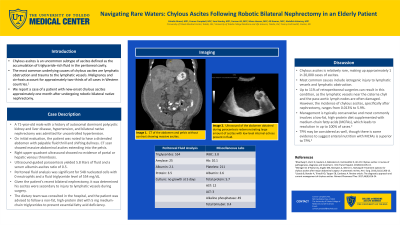Monday Poster Session
Category: Liver
P3134 - Navigating Rare Waters: Chylous Ascites Following Robotic Bilateral Nephrectomy in an Elderly Patient
Monday, October 28, 2024
10:30 AM - 4:00 PM ET
Location: Exhibit Hall E

Has Audio

Connor Campbell, MD
University of Toledo College Medicine and Life Sciences
Toledo, OH
Presenting Author(s)
Zohaib Ahmed, MD1, Connor Campbell, MD2, Sara Stanley, MD2, Farman Ali, MD3, Mona Hassan, MD2, Ali Nawras, MD1, Abdallah Kobeissy, MD2
1University of Toledo Medical Center, Toledo, OH; 2University of Toledo College Medicine and Life Sciences, Toledo, OH; 3Henry Ford Health, Canton, MI
Introduction: There are many etiologies responsible for ascites in elderly patients. A relatively uncommon subtype is chylous ascites, defined as the accumulation of triglyceride-rich peritoneal fluid in the peritoneal cavity. The most common underlying causes of chylous ascites are lymphatic obstruction and trauma to the lymphatic vessels. We report a case of a patient with new-onset chylous ascites approximately one month after undergoing robotic bilateral native nephrectomy.
Case Description/Methods: A 71-year-old male with a history of autosomal dominant polycystic kidney and liver disease, hypertension, and bilateral native nephrectomy was admitted for uncontrolled hypertension. On initial evaluation, the patient was noted to have a distended abdomen with palpable fluid thrill and shifting dullness. CT scan showed massive abdominal ascites extending into the pelvis. RUQ ultrasound showed no evidence of portal or hepatic venous thrombosis. Ultrasound-guided paracentesis was performed, which yielded 5.8 liters of fluid and a serum albumin-ascites ratio of 0.5. Peritoneal fluid analysis was significant for 548 nucleated cells with 0 neutrophils and a fluid triglyceride level of 554 mg/dL. Given the patient’s recent bilateral nephrectomy, it was suspected that his ascites were secondary to injury to lymphatic vessels during surgery. The dietary team was consulted in the hospital, and the patient was advised to follow a non-fat, high-protein diet with 5 mg medium-chain triglycerides to prevent essential fatty acid deficiency.
Discussion: Chylous ascites is relatively rare, making up approximately 1 in 20,000 cases of ascites. Most common causes include iatrogenic injury to lymphatic vessels and lymphatic obstruction. Up to 11% of retroperitoneal surgeries can result in this condition, as the lymphatic vessels near the cisterna chyli and the para-aortic lymph nodes are often damaged. However, the incidence of chylous ascites, specifically after nephrectomy, ranges from 0.013% to 5.9%. Management is typically conservative and most commonly involves a low-fat, high-protein diet supplemented with medium-chain fatty acids, though TPN is also often considered.
Disclosures:
Zohaib Ahmed, MD1, Connor Campbell, MD2, Sara Stanley, MD2, Farman Ali, MD3, Mona Hassan, MD2, Ali Nawras, MD1, Abdallah Kobeissy, MD2. P3134 - Navigating Rare Waters: Chylous Ascites Following Robotic Bilateral Nephrectomy in an Elderly Patient, ACG 2024 Annual Scientific Meeting Abstracts. Philadelphia, PA: American College of Gastroenterology.
1University of Toledo Medical Center, Toledo, OH; 2University of Toledo College Medicine and Life Sciences, Toledo, OH; 3Henry Ford Health, Canton, MI
Introduction: There are many etiologies responsible for ascites in elderly patients. A relatively uncommon subtype is chylous ascites, defined as the accumulation of triglyceride-rich peritoneal fluid in the peritoneal cavity. The most common underlying causes of chylous ascites are lymphatic obstruction and trauma to the lymphatic vessels. We report a case of a patient with new-onset chylous ascites approximately one month after undergoing robotic bilateral native nephrectomy.
Case Description/Methods: A 71-year-old male with a history of autosomal dominant polycystic kidney and liver disease, hypertension, and bilateral native nephrectomy was admitted for uncontrolled hypertension. On initial evaluation, the patient was noted to have a distended abdomen with palpable fluid thrill and shifting dullness. CT scan showed massive abdominal ascites extending into the pelvis. RUQ ultrasound showed no evidence of portal or hepatic venous thrombosis. Ultrasound-guided paracentesis was performed, which yielded 5.8 liters of fluid and a serum albumin-ascites ratio of 0.5. Peritoneal fluid analysis was significant for 548 nucleated cells with 0 neutrophils and a fluid triglyceride level of 554 mg/dL. Given the patient’s recent bilateral nephrectomy, it was suspected that his ascites were secondary to injury to lymphatic vessels during surgery. The dietary team was consulted in the hospital, and the patient was advised to follow a non-fat, high-protein diet with 5 mg medium-chain triglycerides to prevent essential fatty acid deficiency.
Discussion: Chylous ascites is relatively rare, making up approximately 1 in 20,000 cases of ascites. Most common causes include iatrogenic injury to lymphatic vessels and lymphatic obstruction. Up to 11% of retroperitoneal surgeries can result in this condition, as the lymphatic vessels near the cisterna chyli and the para-aortic lymph nodes are often damaged. However, the incidence of chylous ascites, specifically after nephrectomy, ranges from 0.013% to 5.9%. Management is typically conservative and most commonly involves a low-fat, high-protein diet supplemented with medium-chain fatty acids, though TPN is also often considered.
Disclosures:
Zohaib Ahmed indicated no relevant financial relationships.
Connor Campbell indicated no relevant financial relationships.
Sara Stanley indicated no relevant financial relationships.
Farman Ali indicated no relevant financial relationships.
Mona Hassan indicated no relevant financial relationships.
Ali Nawras indicated no relevant financial relationships.
Abdallah Kobeissy indicated no relevant financial relationships.
Zohaib Ahmed, MD1, Connor Campbell, MD2, Sara Stanley, MD2, Farman Ali, MD3, Mona Hassan, MD2, Ali Nawras, MD1, Abdallah Kobeissy, MD2. P3134 - Navigating Rare Waters: Chylous Ascites Following Robotic Bilateral Nephrectomy in an Elderly Patient, ACG 2024 Annual Scientific Meeting Abstracts. Philadelphia, PA: American College of Gastroenterology.
